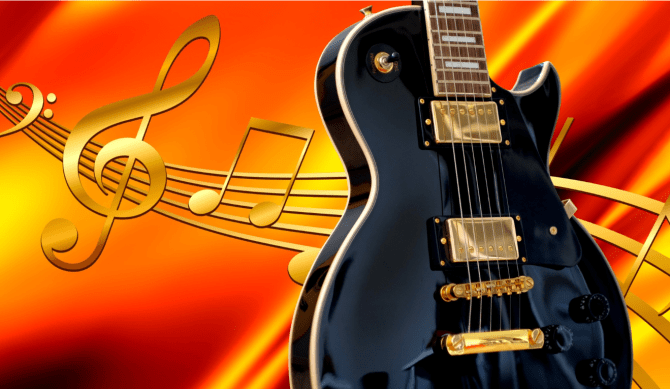
April is International Guitar Month. One of the most recognizable instruments in music, the guitar has been a part of many genres of music. Guitar has appeared in differing forms throughout many types of classical form. Today, electric guitars dominate much of the modern music genres, including variants of rock, jazz, and country music to name only a few. Guitars come in many varieties, including the classic acoustic guitar, six-string guitar, twelve-string guitar, bass guitar, among many others. All variants of guitar involve plucking strings with finger placement on the neck of the guitar to play tones, using the string vibrations to create sound.
The guitar is an instrument that has been essential to music for centuries. While many people think of Spanish music when it comes to early guitar, historians believe that guitar-like instruments date all the way back to the days of ancient Egypt. The Moors are credited for bringing the guitar from Africa to Europe when they invaded Spain in 711 A.D. Spanish guitar maker Antonio de Torres Jurado designed the modern guitar in the late 1800s. In addition, Spanish guitarist and composer Francisco Tarrega developed the modern guitar-playing methods at that time.
Guitar evolved even further in design and music in the 1930s with the development of the electric guitar. Unlike the modern acoustic guitar, which uses the vibration of the strings with the resonant body of the instrument to produce sound, the electric guitar converts the string vibrations to electrical signals. These signals are then converted and shaped through an amplifier, which then produces the sounds through the speaker. Electric guitars typically have dials on the body used to control tone and volume. Some electric guitars feature a tremolo arm, also called vibrato arm or whammy bar, to tighten and loosen strings, creating textured sounds. Early electric guitars had the hollow resonant body of acoustic guitars. The solid body electric guitar design began in 1941 through American guitarist Les Paul. In the 1950s, Paul assisted the Gibson company in designing a popular line of electric guitars. In addition, American inventor Leo Fender also designed many popular electric guitars through the 1940s and 1950s, including the Telecaster and the Stratocaster. Fender’s electric guitar designs and other designs named after Les Paul remain popular today.

Whether you wish to learn the basics of guitar, pick up pieces for the classic acoustic guitar, or learn your favorite tunes with an electric guitar or a bass guitar, the St. Tammany Parish Library has a number of resources pertaining to playing guitar for those interested in learning the instrument. The library collection has several books and DVDs designed to teach someone to play guitar, including sources dedicated to the bass guitar. The Hobbies & Crafts Reference Center database features printable pdf sources pertaining to guitar playing. Regardless of the style of music one wishes to pursue pertaining to guitar, whether one is just starting out or wanting to learn some favorite songs, the library features sources designed to help anyone with their guitar needs.
To learn more about guitars or how to play guitar, check out these sources:
Check out these sources to learn how to play guitar and learn the history of this popular musical instrument.
Goertzen, V. (2023). Guitar. In World Book Advanced.
https://www.worldbookonline.com/advanced/article?id=ar239580
Corey, J. (2023). Electric guitar. In World Book Advanced.
https://www.worldbookonline.com/advanced/article?id=ar753947


Add a comment to: International Guitar Month